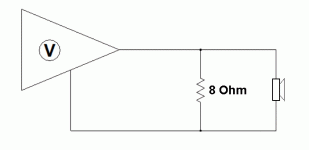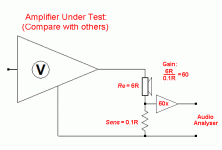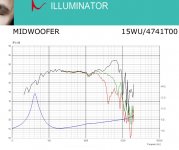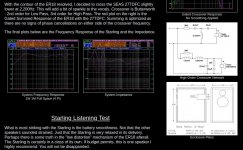This is the most activity on the thread since pretty much Jan of 2020 and it is 100% repeated tropes of the same cast of characters. I hope I'm not the only one learning (reinforcing) a lesson learned.
Maybe Joe is like a Cicada? We can but hope...
I am afraid that we all speak about different things. Kii 3 is an example how to make a SOTA improvement in bass driver properties. Zobels, impedance flattening, half I half V drive are not. They are just amateurish attempts with no practical output.
Hi Pavel,
Good to see you around. Enjoyed your comments on the D'Agostino M550 in the Stereophile comments section. Truly Abysmal measurements for a $45000/pr amplifier.
The science has changed. Some choose not to move.
But not only the usual suspects, the leopard that cannot change its spots.
Even speaking in the first person is demonised. The post above me starts with "I wish" and everybody else does it.
Amateur psychologists, that's pretty lame. Some of you guys should look home before somebody else's house.
The science stuff just got completely ignored.
But not only the usual suspects, the leopard that cannot change its spots.
Even speaking in the first person is demonised. The post above me starts with "I wish" and everybody else does it.
Amateur psychologists, that's pretty lame. Some of you guys should look home before somebody else's house.
The science stuff just got completely ignored.
Last edited:
Cool! Could you please show us the changed science? I assume Ohm's law and Kirchhoff's law still apply. What has changed exactly? And if the science has changed, then why do you keep saying the exact same things using the exact same words year after year?The science has changed.
Even speaking in the first person is demonised. The post above me starts with "I wish" and everybody else does it.
I did not "demonize" anything, I quantified. Can you count? I challenge you to search your posts for the last two or more years and count how many times you referred to yourself, then compare that to me or anyone else on this forum. You are the very definition of "ego", you are the only thing you talk about.
The science stuff just got completely ignored.
By whom exactly? What actual new science have you brought here? What sort of response are you looking for? It seems to me that you show up here every now and then, and announce that you finally understand Ohm's Law and it is going to revolutionize everything, and a physicist you know agrees that Ohm's Law holds.
So I (That's I - not someone else...) put all the parts onto a board to mount behind the amp. I found it clear that the impedance transformer didnt like the speaker cable load, so I ripped it all apart and put each tranny just below the driver.
The speaker cable drives the 8 Ohm "ballast" resistor, while the Hi-Z output connects to the speaker through short 'n spread wires.
I'm guessing any capacitance presented by the longer parallel wires of the speaker cable - reflected back through the transformer - was a no-no.
As long as that other Joe is getting all the attention, thought I'd just chime in here with what's happening in my room. ;')
The speaker cable drives the 8 Ohm "ballast" resistor, while the Hi-Z output connects to the speaker through short 'n spread wires.
I'm guessing any capacitance presented by the longer parallel wires of the speaker cable - reflected back through the transformer - was a no-no.
As long as that other Joe is getting all the attention, thought I'd just chime in here with what's happening in my room. ;')
"‘Wisdom is better than mightiness; yet a poor man’s wisdom is despised, and his words are not heeded." Solomon
Wait a minute, Joe. That's Ecclesiastes isn't it? Or I'm a Chinaman.
A notoriously gloomy prophet. Best avoided, IMO.
Chapter 9: "Death Comes to All". I bet that one flew off the shelves. 🙄
Well really. Hardly the LIfe and Soul of the party. 😀
A notoriously gloomy prophet. Best avoided, IMO.
Chapter 9: "Death Comes to All". I bet that one flew off the shelves. 🙄
Well really. Hardly the LIfe and Soul of the party. 😀
I'm impressed, yes it is. I love stuff like that and I have more quotes from his Probs. That is not gloomy at all, the full gamut of emotions, and a song about sex?
BTW, what is that thing at the waterfront at Portsmouth that I have seen 'flying' over? I start out a Southport Airport, then go over the city, swing a hard left and then Portsmouth. The swing left and 'fly' over to the Isle of Wight, take a look at the Queen's place.
I found out my schizophrenic son who hears voices, and now he also has been diagnosed with OCD (obsessive compulsive disorder). Maybe I have some of that? So any associated barbs, as they say, is water of a duck's back. The local amateur psychologist says I am self-obsessed? So what, aren't we all to a degree? He must have spent an hour plus roaming through my posts over the last week and listed where I said "I" and he thinks that I am the only one with a problem? That's hilarious, momentarily he got obsessed with moi. I have a mountain of life problems on my shoulders right now, so should I give a rat's ***? I am doing OK.
"Better the anger of a friend than the kiss of an enemy." Solomon
Is he a friend or a kisser?
Point is, "I" just don't care anymore, and "I" just see the ridiculousness of it and how stupid it is, and what is stupid is often funny.
Enough of that, the next post will get that to the real topic at hand.
BTW, what is that thing at the waterfront at Portsmouth that I have seen 'flying' over? I start out a Southport Airport, then go over the city, swing a hard left and then Portsmouth. The swing left and 'fly' over to the Isle of Wight, take a look at the Queen's place.
I found out my schizophrenic son who hears voices, and now he also has been diagnosed with OCD (obsessive compulsive disorder). Maybe I have some of that? So any associated barbs, as they say, is water of a duck's back. The local amateur psychologist says I am self-obsessed? So what, aren't we all to a degree? He must have spent an hour plus roaming through my posts over the last week and listed where I said "I" and he thinks that I am the only one with a problem? That's hilarious, momentarily he got obsessed with moi. I have a mountain of life problems on my shoulders right now, so should I give a rat's ***? I am doing OK.
"Better the anger of a friend than the kiss of an enemy." Solomon
Is he a friend or a kisser?
Point is, "I" just don't care anymore, and "I" just see the ridiculousness of it and how stupid it is, and what is stupid is often funny.
Enough of that, the next post will get that to the real topic at hand.
Richard suggested the circuit below. It is really tricky, when analyzed. Regarding current drive...
I recall that I posted a diagram where it was a voltage source and not current, at which Richard said he and others had heard the effects of that 8R resistor in my diagram. See attachment below, this was what Richard was commenting on when I posted it back there.
I am sure you didn't mean to, but you tried to change history. But your example behaved exactly as it should and I have used parallel resistors that way too.
The attachment below is what Richard saw and said he had heard the effect it had.
So if it is audible, then what is that 8R parallel resistor doing?
Do you not believe this is a valid question to ask?
BTW, when you say in your tweeter tests on your website, that it was the speaker's current that you measured, didn't you get that wrong?
Please let me explain. The tweeter doesn't produce current. The amplifier does. So you were comparing the distortion of the voltage side of the amplifier, and with your 1R current sense resistor, you were measuring the distortion of the amplifier's current. So the current output of the amplifier is distorted by the non-linearities of the driver. You then measured the acoustic output (I have done the same) and sure enough, there it was, the amplifier's distortion on the current side turns up as distortion that is heard.
So the added distortion you get from the voltage source, is a combination of two things. But with current-drive, you are left with the non-linear distortion of the tweeter, only that. The added distortion comes from using a voltage source because the amp can only precisely control the voltage, but to do that, it has to relinquish all control of the current, so now the tweeter can affect the amplifier and distort its current. This is the key to understanding the lower distortion you got with current-drive.
I remember trying to explain this to you earlier and I wonder if you are a little more receptive this time?
I hope, but if not, then let us disagree in a gentlemanly manner, OK? Agree to disagree?
But please, try to understand the logic expressed above, please don't dismiss it and make no attempt. I can only ask that you do that and no more.
I for one do not want to stop there, to me the above is a door to open and see. I did and I found things that few talk about. Some OCD can be useful. 🙂
I do believe that parallel 8R resistor would have shown up if they were incorporated in your measurements. In terms of distortion, it might have been a half-way house?
I wish you had. The distortion of the tweeter would not have been reduced (that will always be there, no matter how it is driven), but the distorted current would have been reduced. And you proved that can be measured. But I would use a smaller current sense value than 1R, but I know how much more tricky that is.
Please see the two attachments, one that RNM commented on and the setup I use with 0.1R and using s small low distortion side amp.
I hope the conversation can be civil and I hope it leads to something better.
Cheers, Joe
PS: To Steve, what do you make of the above? Do you follow the logic?
Attachments
It’s a pitty that Petr_2009 is not joining the ongoing discussion.
You two could create a whole new parallel universe, thereby constantly telling that nobody is smart enough to understand.
Suggesting things but evading all confrontation with real world tests.
May I politely call this a sort of misunderstood genius syndrome 😀
Hans
You two could create a whole new parallel universe, thereby constantly telling that nobody is smart enough to understand.
Suggesting things but evading all confrontation with real world tests.
May I politely call this a sort of misunderstood genius syndrome 😀
Hans
Joe, I am very good at amplifiers in a general sense. I was employed as a system engineer on a 50 ohm submarine telephone cable system. Everything was 50 ohms. Even the plugs. No problems with echoes, group delay or anything. Almost perfection apart from lossy cables on 3 mile runs.
I mentioned my thought experiment on amplifiers:
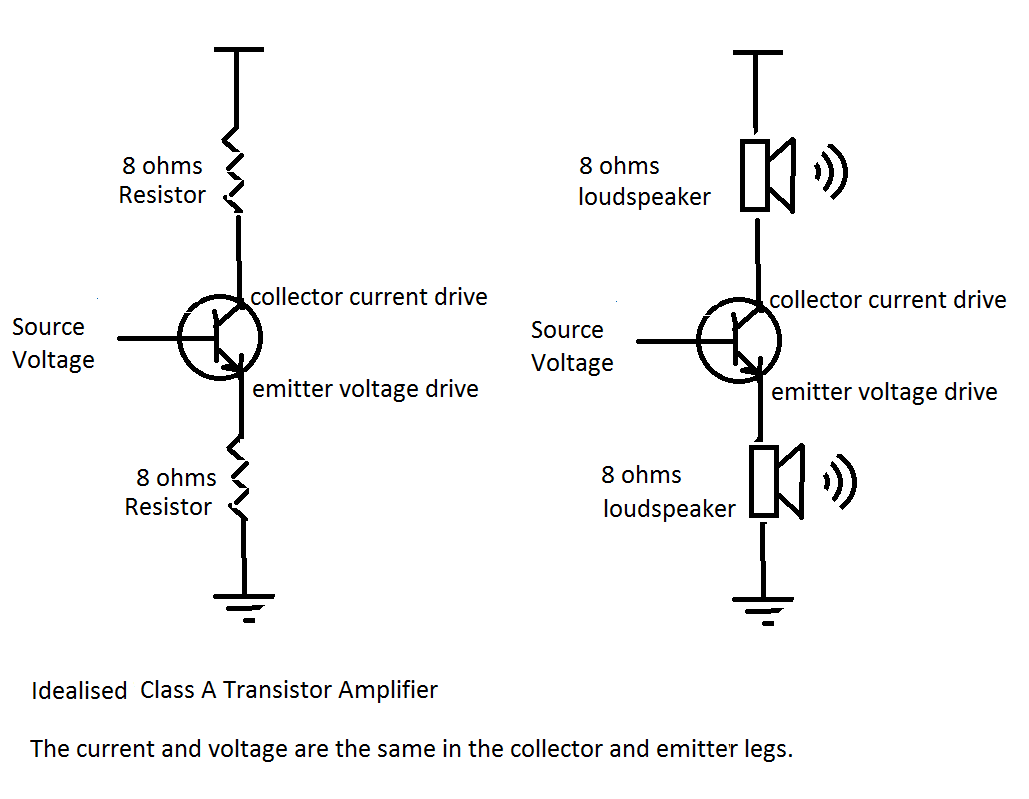
See, one loudspeaker gets current drive, the other gets voltage drive. They end up the SAME! There is no other conclusion if the transistor has good gain! 😀
But I do think impedance matters. Those old BBC engineers often came from a Radio and Radar background, where good impedance matching makes or breaks the system. As we know, butterworth is a maximally flat system on power and impedance when implemented correctly. Lot to learn from this Rogers LS5/9 speaker. I wouldn't be surprised if our own ex-BBC engineer Morgan Jones was involved. World expert on transformer matching.
BBC and Rogers Loudspeakers › BBC LS5/9
I wasn't joking when I said your Hamlet design gave me a hard time to get working:
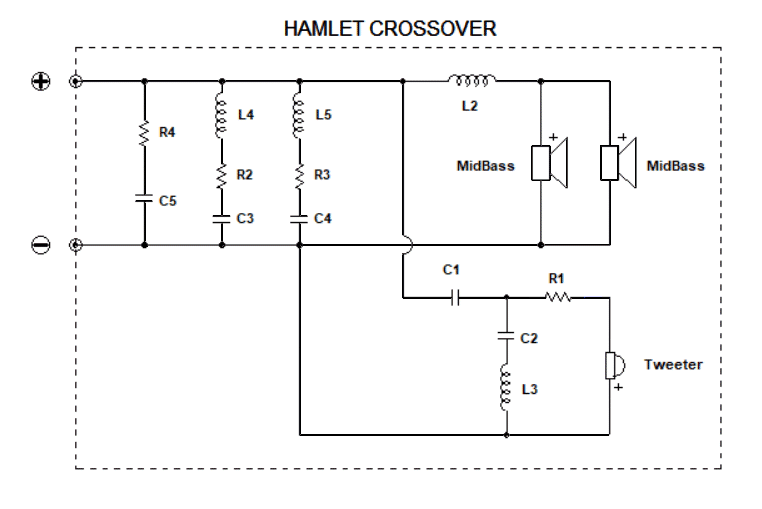
I just happen to know, as you do too, that a 6" bass usually needs a LCR notch around 5kHz to act sensibly. A single coil doesn't usually hack it.
I mentioned my thought experiment on amplifiers:
See, one loudspeaker gets current drive, the other gets voltage drive. They end up the SAME! There is no other conclusion if the transistor has good gain! 😀
But I do think impedance matters. Those old BBC engineers often came from a Radio and Radar background, where good impedance matching makes or breaks the system. As we know, butterworth is a maximally flat system on power and impedance when implemented correctly. Lot to learn from this Rogers LS5/9 speaker. I wouldn't be surprised if our own ex-BBC engineer Morgan Jones was involved. World expert on transformer matching.
BBC and Rogers Loudspeakers › BBC LS5/9
I wasn't joking when I said your Hamlet design gave me a hard time to get working:

I just happen to know, as you do too, that a 6" bass usually needs a LCR notch around 5kHz to act sensibly. A single coil doesn't usually hack it.
I mentioned my thought experiment on amplifiers:
See, one loudspeaker gets current drive, the other gets voltage drive. They end up the SAME! There is no other conclusion if the transistor has good gain! 😀
They would be out of phase of course. And what it is basically a phase splitter when a tube is used, a number of brands like Dynaco.
But I do think impedance matters. Those old BBC engineers often came from a Radio and Radar background, where good impedance matching makes or breaks the system. As we know, butterworth is a maximally flat system on power and impedance when implemented correctly. Lot to learn from this Rogers LS5/9 speaker. I wouldn't be surprised if our own ex-BBC engineer Morgan Jones was involved. World expert on transformer matching.
I know it is going to irk some people here, saying that I have met him a couple of times at various ETF meetings. I remember ETF17 and we were finishing up on Sunday and we talked about the Biscuit thing (it almost rhymes with that, you know what I mean) and he was definitely not pro-Biscuit. I asked him if it was possible to unscramble the egg because that is what it struck me as like. He said that there were people who wanted to do just that no matter the cost. They were just mad anti-Euro and wanted it ripped up and different care. He was almost angry. But mostly a very humorous chap otherwise. He did a very funny presentation of grounding in audio. That was a hoot and he had the crowd in his hands. 🙂
I just happen to know, as you do too, that a 6" bass usually needs a LCR notch around 5kHz to act sensibly. A single coil doesn't usually hack it.
I used to do that, now I rarely do. In many drivers, not all, the peak is caused by a horn effect because of the cone and VC cap shapes. You can tell this if the off axis at even just 15 degrees, it has been severely depressed and you can also check the CSD plot to see if there are underlying ridges/distortion. If they are largely absent, I almost ignore the peak.
There is another thing, look at the driver below (see attachment) which is the legendary Vifa P17WJ driver which is almost flat.
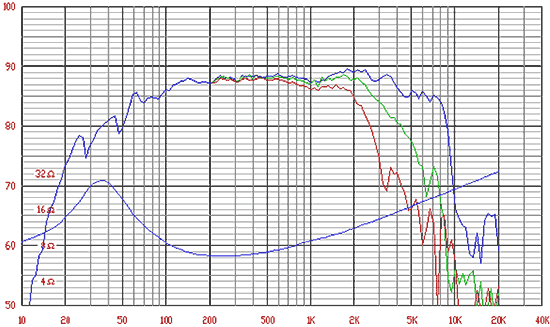
Looks deceptively smooth, yet there is a problem.
This is because the inductance is 0.55mH - but if your were to take a similar size driver in the SB Acoustics range, like SB17MFC, also a poilycone driver, which has a significant peak, but the inductance is 0.15mH. But add 0.4mH to 0.15mH to match the inductance of the Vifa, then they look a lot more closer. The low inductance SB17MFC looks worse, but it is not, in fact, it is the superior driver, in fact, it is a beauty.

With added 0.4mH series inductor, it will look much smoother than what it looks like above.
There are other reasons that I don't adjust it with an LCR any more.
If three people sat on a 3-person couch, only the centre person will get the correct stereo image. But the other two, they should still get something acceptable. If you design for 15 degrees off axis and the finished speakers are positioned so that they are toed in so that the ends of the couch if you were sitting there, you would be on axis. But sitting on the left or right side, you would still see the inside of the box. None of the three persons will be on axis. Now take a mic and play some non-coincident pink noise and what 1/6th octave RTA, and from left to right, all three persons will hear a response that is within 1dB above 1KHz and at the correct listening height.
So that is why I don't do it anymore. Driver selection is the important bit. Sometimes the better driver can look worse.
Also, adding 0.4mH external inductor in series with very non-linear 0.15mH, it's easy to see that you are swamping that non-linearity to a good degree. Then EQ the current flat for the amplifier to see, and the sound becomes similar to current-drive, yet the amplifier is not current-drive.
BTW, that three-man couch test, with the Elsinores in my system, the response variation is within 0.5dB and guess what drivers are used? Yep, the SB17MFC that described above as a beauty!
Cheers, Joe
Last edited:
Also, adding 0.4mH external inductor in series with very non-linear 0.15mH, it's easy to see that you are swamping that non-linearity to a good degree. Then EQ the current flat for the amplifier to see, and the sound becomes similar to current-drive, yet the amplifier is not current-drive.
Isn't the reduction in distortion due to the speaker seeing a larger impedance, as I think KSTR was saying, if I understood him correctly?
I always find that smaller bass coils sound better on clarity, even if it can be bass light.
Amusingly, after all the effort SB Acoustics put into reducing inductance in the voice-coil, you end up putting it back in the crossover to tame the peaks... 🙂
I must agree with Joe that good driver selection will make life much easier for your average diy-er who has not a clue about the mysteries of X-Sim and such.
They rock up with some difficult driver like an expensive Scanspeak 15WU-4741T00. Actually a very good sounding thing in the right hands, and darn good at (green) 30 degrees.
Enlightenment – Scanspeak 15WU with Morel CAT378 – AmpsLab
But clearly is going to need a 5kHz notch, impedance correction and bafflestep. Mike Chua knew what to do with it on what is a first order crossover. And yes, I look at off-axis myself. Because I listen off-axis mostly. But the typical designers only look at on-axis don't give much thought to dispersion or power response.
Amusingly, after all the effort SB Acoustics put into reducing inductance in the voice-coil, you end up putting it back in the crossover to tame the peaks... 🙂
I must agree with Joe that good driver selection will make life much easier for your average diy-er who has not a clue about the mysteries of X-Sim and such.
They rock up with some difficult driver like an expensive Scanspeak 15WU-4741T00. Actually a very good sounding thing in the right hands, and darn good at (green) 30 degrees.
Enlightenment – Scanspeak 15WU with Morel CAT378 – AmpsLab
But clearly is going to need a 5kHz notch, impedance correction and bafflestep. Mike Chua knew what to do with it on what is a first order crossover. And yes, I look at off-axis myself. Because I listen off-axis mostly. But the typical designers only look at on-axis don't give much thought to dispersion or power response.
Attachments
It's the same thing, in the end.Isn't the reduction in distortion due to the speaker seeing a larger impedance, as I think KSTR was saying, if I understood him correctly?
When we have an Le variation of, say 10% (and actually it's a very complex "Le") and series cell that has 10x the impedance, the effect is reduced to 1%. The benefit of an inductor is that it is low impedance at LF and therefore little power loss. It also makes the life a bit easier for the preceding filter element as the load impedance is more constant./predictible.. though higher so you may want to add parallel R to bring the load down and make it even more constant.
Such a driver is a good example why high impedance drive can make a difference. When you have a 5kHz -10dB notch, and let's assume it's in an active XO preceding the amp, it does nothing for the H3 motor distortion at 1.6kHz (or H2 at 2.5kHz) which still get this free mechanical boost.Enlightenment – Scanspeak 15WU with Morel CAT378 – AmpsLab
But clearly is going to need a 5kHz notch, impedance correction and bafflestep
---:---
As a closing comment for mixed-impedance or (quasi-)current drive from my view at this point, I find it's most useful within active speakers with cheap drivers where Le(x) really is a dominant error source. But they should have shorting ring(s) so that BL(i) is nice. And AMTs always like current drive IME. Further, any power compression also is less severe the higher the drive impedance, again notably for small AMTs.
You can get high impedance drive with careful bafflestep design. I was interested in this example by Mike Chua, the Starling. Passive bafflestep. 4.7R on the midbass filter in effect.
Seas ER18RNX with 27TDFC
Solves a lot of problems, Bafflestep mucks up most filters and the source impedance seen by the bass. He remarked it sounded smooth. Sorry its hard to read.
Seas ER18RNX with 27TDFC
Solves a lot of problems, Bafflestep mucks up most filters and the source impedance seen by the bass. He remarked it sounded smooth. Sorry its hard to read.
Attachments
- Home
- Member Areas
- The Lounge
- The Black Hole......
